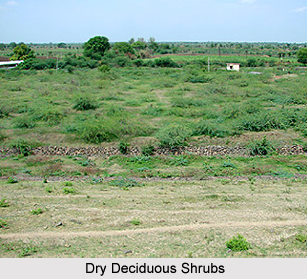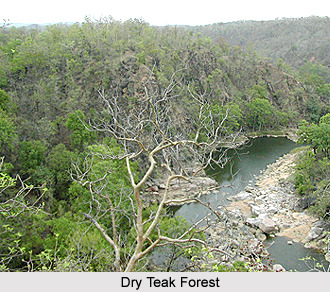 Flora of Dhar District is quite abundant. In Dhar District, the vast forests include some interesting vegetation. Forest cover in this district of Madhya Pradesh is quite high and it houses some incomprehensible diversity of trees, flowers, and other shrubs. Several species of teak trees are also found here. The main categories of flora in Dhar District are mentioned below.
Flora of Dhar District is quite abundant. In Dhar District, the vast forests include some interesting vegetation. Forest cover in this district of Madhya Pradesh is quite high and it houses some incomprehensible diversity of trees, flowers, and other shrubs. Several species of teak trees are also found here. The main categories of flora in Dhar District are mentioned below.
Dry Teak Forests: The dry teak is found on the middle and lower slopes of the Vindhya scarp on the mixed black and sandy granite soil. It occurs extensively on the eastern and northern slopes of Bagh, Sardarpur, Dhamnod and Manawar ranges. They occupy about 331 sq km in the alluvial parts of valleys of the Khuj, the Man, the Karam, the Bagh and the Keshawi. This is the peak vegetation of the area stabilised by the reduction of other varieties due to grazing and fires. Over the rich and deeper alluvial mantle and sandy loam with minimum biotic interference, a more moist type is found in the sheltered valleys of Kalghati, Kheri, Kuan, Khirkiyan, Anjnai and Parbatpura. In such areas, the teak trees with an increased number of associate species usually fill up the top canopy.
Very Dry Teak Forests: Under very dry conditions, the very poor quality of teak forests is found on the upper contours of the Vindhya Mountain scarps. The percentage of teak decreases with the increase of dry deciduous species like, salai, dhava, aonla, reunjha, moyan, etc. An increase in the shrubs, herbs, grasses and climbers is clearly marked.
 Mixed Forests: The Mixed forests vary from the general type to the admixture of a large number of species to dry types like that of salai and the maltreated areas of scrubs and grasses. These occur over very undulating topography over Nimar sandstone and quartzite. They occupy the southwestern part of Dhar District and stray hills south of the scarps. Among the associates salai, anjun, saj and chloroxylon swietenia are most widespread. Top canopy is found in the best of these forests. Like those in the teak forests, they consist of diverse species. Teak, sadar, moyan, dhava, tendu, kari, bija, rohan, kalam, kasai, bel, lendia, salai, shisham and kareya-saja.
Mixed Forests: The Mixed forests vary from the general type to the admixture of a large number of species to dry types like that of salai and the maltreated areas of scrubs and grasses. These occur over very undulating topography over Nimar sandstone and quartzite. They occupy the southwestern part of Dhar District and stray hills south of the scarps. Among the associates salai, anjun, saj and chloroxylon swietenia are most widespread. Top canopy is found in the best of these forests. Like those in the teak forests, they consist of diverse species. Teak, sadar, moyan, dhava, tendu, kari, bija, rohan, kalam, kasai, bel, lendia, salai, shisham and kareya-saja.
Salari Forests: The edaphic subtype of the Dry Deciduous Mixed forest is found over the dry hills and ridges of Ramgarh, Jamli, Neemkeda, Manasamal and Mian pahad forest blocks. The trees are not very well grown. They grow to about 10 metres in height and one metre in girth. At places, it has very clearly come up as the residual form of vegetation after the general maltreatment by men and selective exploitation of other species. The common associates in the edaphic sub-type are salar, moyan, dhava, khair, gadhu and in stunted form, teak.
Anjan Forests: Anjan forests are found in some of the maltreated areas of Dry Deciduous forests. They occupy the western portion of Vindhyan scarps and area between the valleys of Narmada and Bagh. The country is typified by poor soil on hard laterite, aeration and drainage. Anjan is seen in green leaves all the year round. Its leaves are also used as cattle feed. This together with problematic regeneration has left it in to poor conditions. The forest is open with dimensions of trees up to 10 metres in height and one metre in girth.
Dry Deciduous Scrub Forests: The scrub forests are confined to the immediate slopes of Malwa Plateau from Mandu to Bamanpuri and Panara blocks. The denuded ground and dry and shallow soil under the stemmed and crooked stock of babul, bel, hingan, sindi, etc. indicate that these have been converted to the present stage from Dry teak forests. The soil is generally Lateritic invaded by several thorny species.
Apart from these forests, flora of Dhar District also includes great varieties of herbal plants and shrubs.



















